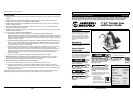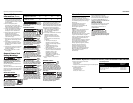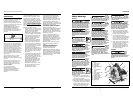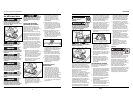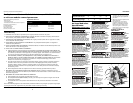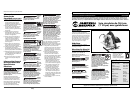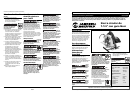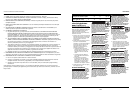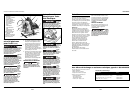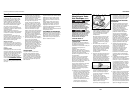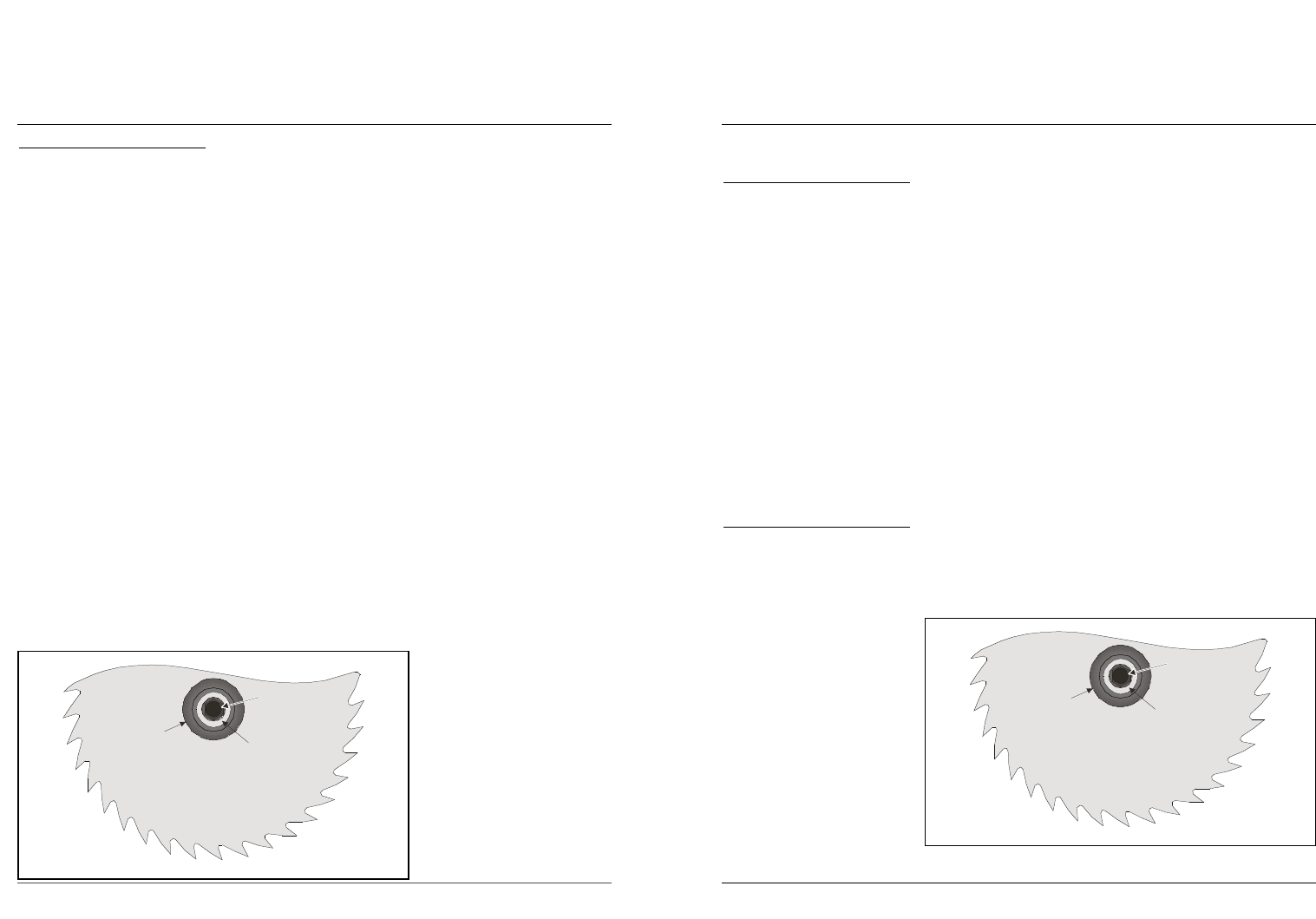
Ensamblaje
GUÍA LÁSER
Instalación de las baterías
1. Asegúrese de que el interruptor
de la guía láser esté apagado
(presionando el “O” en el
interruptor oscilante).
2. Usando un destornillador Phillips
pequeño, quite el pequeño tornillo
de seguridad.
3. Levante la tapa del compartimiento
de las baterías con un cuchillo romo
en proximidad del hueco del
tornillo.
4. Instale dos baterías AAA observando
la orientación/polaridad grabada en
el compartimiento de las baterías.
5. Vuelva a colocar la tapa del
compartimiento de las baterías
y apriete suavemente el pequeño
tornillo de seguridad.
Ajuste del rayo láser
El rayo láser ha sido
preajustado/alineado de fábrica pero,
debido al manejo, puede haberse
desplazado de su posición preajustada.
Para verificar la alineación del rayo
láser, primero asegúrese de que el bisel
de la sierra esté ajustado a cero
(es decir, la sierra no está en ángulo)
y luego encienda el láser por el
interruptor. Verifique que el láser esté
alineado con la marca del 0° en la
parte delantera de la placa base. Si no
está alineada con este borde, tome
una pinza de punta fina y suavemente
sujete la parte de bronce del láser.
Gire esta parte hasta que el rayo láser
quede alineado con la línea de corte
de la base.
CÓMO COLOCAR LA HOJA
Para instalar la hoja
1. Asegúrese de que el interruptor
esté en la posición “off” (apagado)
y que la sierra esté desconectada de
la fuente de energía.
2. Si el vástago tuviese una arandela,
brida, y un tornillo para la hoja,
retire el tornillo, la arandela debajo
de este tornillo, y la brida cuyo
orificio tiene caras paralelas.
Tome nota de la orientación de las
piezas que ha quitado.
Nota: Sobre el vástago debería quedar
otra brida desmontable. Debe quedar
en su lugar y debe estar orientada de
manera que la cara más grande de la
brida quede hacia el lado externo de
la sierra.
3. Sujete el mango de la protección
inferior de la hoja y abra esta
protección a su posición
completamente abierta.
4. Con la hoja orientada con se indica
abajo, desde el fondo de la sierra
deslice la hoja sobre el vástago.
Asegúrese de que la hoja quede
dentro de la protección inferior de
la hoja y entre la pequeña
protección delantera y la sierra
misma.
5. Coloque la brida con las caras
paralelas sobre la hoja y el vástago,
asegurándose de que las áreas
planas de la brida combinen con las
áreas planas del vástago y que la
cara más grande de la brida quede
contra la hoja de la sierra. Luego
coloque la arandela plana en el
área en receso de la brida
mencionada arriba.
6. Apriete a mano el tornillo de la
hoja hasta que éste pare contra la
arandela plana. Luego, con la llave
que se proporciona, apriete este
tornillo en sentido horario mientras
presiona el botón de bloqueo del
vástago. Debe quedar firmemente
apretado.
Para retirar la hoja
1. Desconecte la sierra y asegúrese
de que el interruptor esté en la
posición “off” (apagado).
2. Coloque la cabeza de la llave que
se proporciona sobre el perno
hexagonal de la hoja y gire en
sentido antihorario mientras
presiona constantemente el botón
de bloqueo del vástago. A un
momento dado mientras gira,
el bloqueo del vástago se activa
y lahoja de la sierra deja de girar.
Siga presionando el botón de
bloqueo del vástago y retire por
completo el tornillo de la hoja.
Luego retire la brida/arandela que
queda entre la hoja y el tornillo,
tomando nota de la orientación
de estas arandelas.
3. Sujete el mango de la protección
inferior de la hoja y abra la
protección de la hoja a su posición
completamente abierta.
4. Levante la hoja del vástago y hálela
hacia en fondo de la sierra hasta
retirarla por completo.
24 Sp
Manual de Instrucciones y Lista de Piezas
Vista parcial de la hoja con la indicación de la orientación correcta
Hoja
Brida
Arandela plana
Tornillo de la hoja
Safety Instructions
for All Power Saws
(Cont’d.)
2. Check the operation of the lower
guard spring. If the guard and the
spring are not operating properly,
they must be serviced before use.
Lower guard may operate
sluggishly due to damaged parts,
gummy deposits, or a build-up of
debris.
3. Lower guard should be retracted
manually only for special cuts such
as “plunge cuts” and “compound
cuts.” Raise lower guard by
retracting handle and as soon as
blade enters the material, the
lower guard must be released. For
all other sawing, the lower guard
should operate automatically.
4. Always observe that the lower
guard is covering the blade before
placing saw down on bench or
floor. An unprotected, coasting
blade will cause the saw to walk
backwards, cutting whateveris in its
path. Be aware of the time it takes
for the blade to stop after switch is
released.
Assembly
LASER GUIDE
Installing batteries
1. Make sure that the laser guide
switch is turned off (by depressing
the “O” on the rocker switch).
2. Using a small Phillips head
screwdriver, remove the small
securing screw.
3. Lift the battery compartment cover
with a dull blade near the screw
hole.
4. Install two AAA batteries noting
the orientation/polarity that is
molded into this battery
compartment.
5. Replace the battery compartment
cover and lightly tighten the small
securing screw.
Adjusting the laser beam
The laser beam was preset/aligned at
the factory but because of handling,
the laser may have moved from this set
position. To check the alignment of
the laser beam, first make sure that
the saw’s bevel adjustment is set to
zero (that is, the saw is not at an
angle) and then turn on the laser via
its switch. Observe if it the laser beam
aligns with the 0° notch in the front of
the base plate. If it does not align
with this edge, then take a pair of nee-
dle nose pliers and gently grasp the
brass portion of the laser. Rotate this
part until the laser beam lines up with
the base cut line.
ATTACHING THE BLADE
Installing the Blade
1. Make sure that the switch is in the
“off” position and that the saw is
unplugged from the power supply.
2. If there is a washer, flange, and a
blade screw on the spindle, remove
the blade screw, the washer
underneath this screw, and the
flange which has parallel sides on
its bore. Make note of the
orientation of the removed items.
Note: There should be one remaining
removable flange on the spindle. It
should remain in place and be oriented
so that the largest face of the flange is
facing toward the outside of the saw.
3. Grasp the lower blade guard
handle and open this guard to its
fully open position.
4. With the blade oriented as shown
below, slide the blade from the
bottom of the saw onto its arbor.
Make sure that the blade is inside
the lower blade guard and
between the small front guard and
the saw itself.
5. Position the flange which has the
parallel sides on its bore onto the
blade and spindle, making sure that
the flats on the flange match up
with the flats on the spindle and
that the largest face of this flange
is against the saw blade. Then
place the flat washer in the
recessed area of the above-
mentioned flange.
6. Hand tighten the blade screw until
it stops against the flat washer.
Then using the supplied wrench,
tighten this screw clockwise while
depressing the spindle lock button.
It should be snugly tightened in
place.
Removing the Blade
1. Unplug the saw and make sure that
the switch is in the “off” position.
2. Place the head of the supplied
wrench over the hex blade bolt and
turn counterclockwise while
constantly depressing the spindle
lock button. At some point in this
turning process, the spindle lock
will engage and the saw blade will
cease to rotate. Continue to
depress the spindle lock button and
fully remove the blade screw. Then
remove the washer/flange that was
between the blade and screw,
noting the orientation of these
washers.
3. Grasp the lower blade guard
handle and open the blade guard
to its fully open position.
4. Lift the blade off of its spindle and
pull it toward the bottom of the
saw until it is fully removed.
5
www.chpower.com
DG411200CK
Partial view of blade showing its correct orientation
Blade
Flange
Flat washer
Blade screw



